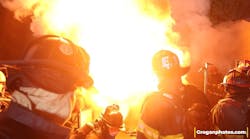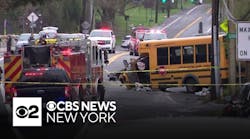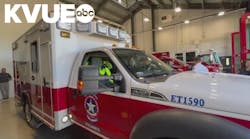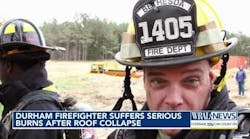- Access/egress routes for quick escape.
- Evacuees fleeing.
- Power lines.
- Hazardous materials, LPG and other fuels, and pesticides.
- Heavy smoke obscuring visibility.
- Heat exhaustion.
- Panicked animals.
- Septic tanks and open wells.
- Products of combustion.
- Entrapment by fast-spreading heavy fire conditions.
Basic Operations
Unless otherwise ordered, place the engine company where it will do the most good and remember, SAFETY and L C E S (refer to parts 1 and 2).
Look around, up and down. Make an assessment of the scene and the situation. Has your structure triage been completed?
Always back your engine into the selected location so that you can make a quick exit if need be. Protect the engine by keeping the windows rolled up; keep motor running; park in an area that is as safe as it can be under the circumstances; cover the hosebed to protect the hose from burning embers; keep headlights and warning on for visibility; and do not block access or egress for other vehicles.
Operational modes of engine companies are offensive (actively and directly fighting the fire); defensive (indirectly fighting the fire from a distance due to extreme fire behavior; and a combination of both.
Evacuation
Residents or other persons may be evacuating in an orderly manner, fleeing in panic, or determined to stay and fight the fire (make note of where they are, how many of them there are - and give them some instruction). It may be better to place them in an safe area of refuge. Use law enforcement agencies to perform evacuation and crowd control.
Wild animals, livestock and domesticated pets may be of concern too but LIFE SAFETY of both your firefighters and other persons comes FIRST.
Rule-Of-Thumb
For single structures surrounded by wildland fuels, assign one engine company; for structures less than 50 feet apart, assign one engine company per two structures. Also provide for an extra engine company to float for every five engines assigned. THIS IS NOT SET IN CONCRETE! Call for more help as the scene dictates.
Lay out and charge one hoseline for the left side and one for the right side of the structure you are protecting, including a short engine safety line. Keep your hoselines limited to 100 to 200 feet and use the appropriate diameter hose for the conditions being encountered. Always leave 100 gallons of water in your engine's tank for safety purposes for your crew.
Wait for the fire to get close enough for the water stream(s) to be effective. Do not pre-wet vegetation or the structure because heat/flames will quickly dry them out. If you are being supplied with a reliable source of water - i.e., a hydrant system - it would be OK to pre-wet ahead of flame front but if operating only with tank water, use water wisely.
The use of Class A foam is one of the best tools to use during SWI fires. The foam dramatically increases water amounts and increases an engine company's capabilities and effectiveness.
An engine company crew can prepare a structure and its surroundings by:
- Closing doors and windows.
- Laying out garden hoses.
- Placing homeowners' extension ladders up to roofs.
- Moving woodpiles and lawn furniture away from structures.
- Cutting vegetation away from structures, if you have the tools to do this, and cleaning out gutters and roofs of dried vegetation.
- Keep in communications and post a lookout to watch for fire movement and spot fires.
Remember your safety zone, which must be accessible and free of combustibles. If you must leave your location in a hurry, take nozzles, uncouple your hoselines at the pump and leave them. After the fire front has passed by, you can return and begin fire suppression.
If you cannot leave your position, enter the structure as a place of temporary refuge until the fire front passes by. This can buy time.
As an absolute last resort, if you are about to be overrun by fire, use the cab of the engine as a place of refuge. Keep the motor running, the pump engaged, all lights on and windows rolled up. Make sure all members are in the cab with all protective clothing and self-contained breathing apparatus (SCBA) donned. Use blankets to cover up and to help shield against radiant heat. Communicate via radio to let others know of your situation. Talk to each other to instill confidence. Try to keep calm. Pray! It all can help.
In Conclusion
To operate safely, effectively and efficiently in a structural wildland fire situation, good judgment, planning, training, the proper equipment and common sense all combine for successful operations. Always remember that SAFETY is the prime concern. NO structure or piece of wildland is worth a serious injury or loss of life!
SUGGESTED REFERENCE BOOKS
Fighting Fire in the Wildland/Urban Interface by Phillip L. Queen, Fire Publications Inc., 9072 Artesia Blvd., Bellflower, CA 90706.
Firefighter's Handbook on Wildland Firefighting and other books by William C. Teie, Deer Valley Press, 5125 Deer Valley Road, Rescue, CA 95672.
Fire Operations in the Urban Interface S-205, Wildland Fire Suppression Tactics, National Interagency Fire Center, ATTN Supply, 3833 S. Development Ave., Boise, ID 83705.
I-Zone Basics by Phillip L. Queen (CD-ROM), Neotec Inc., P.O. Box 9102, Boise, ID 83707.
Robert M. Winston, a Firehouse® contributing editor, is a district fire chief in the Boston Fire Department with extensive experience and training in wildland and SWI protection. Part 1 of this column was published in the April 1998 issue; part 2 appeared in May 1998. He may contacted by e-mail at [email protected]









